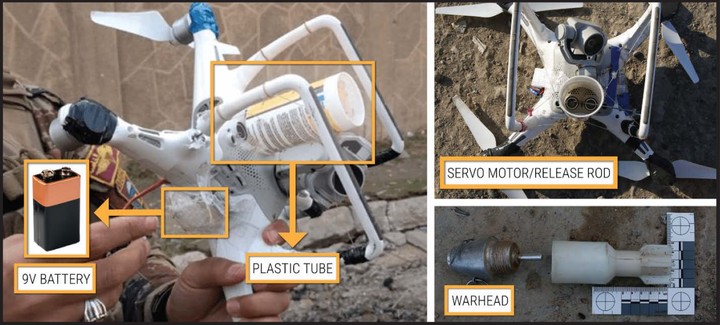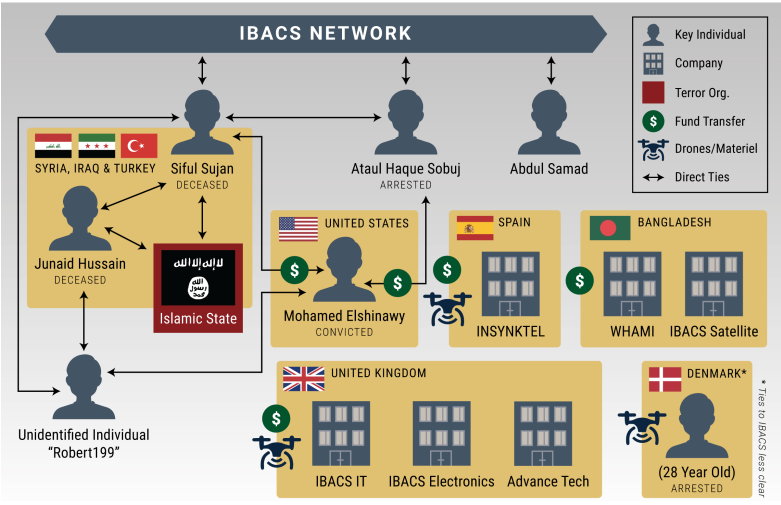How the Islamic State Gets Its Drones
A sophisticated supply chain of shell companies, false identities, and IT entrepreneurs backed the Islamic State’s drone fleet.
Jul 13 2018, 8:00am

The Islamic State hasn’t been completely defeated. Thought it has nothing approaching the burgeoning Caliphate it held in 2015, Islamic State fighters and affiliates are still a deadly presence in Iraq, Syria, Africa, and Afghanistan. As it has lost ground, the Islamic State has turned to more non-traditional methods of attack—including using drones to drop bombs on its enemies.
The drones are typically off-the-shelf quadcopters purchased in other countries then shipped to the Islamic State frontlines and modified in factories before being deployed for use on the battlefield. It’s a tactic that those fighting Islamic State have struggled to fight against. “There was a day [in early 2017] when the Iraqi effort nearly came to a screeching halt, where literally over 24 hours there were 70 drones in the air,” Gen. Raymond Thomas—the head of US Special Operations Command—said during a conference in 2017. “At one point there were 12 ‘killer bees …overhead...and our only available response was small arms fire.”
A new report from West Point’s Combating Terrorism Center explained how Islamic State build its drone fleet on the cheap and also the fascinating story of its complicated supply chain. “The program appears to have been shaped by two Bangladeshi brothers who leveraged companies in the United Kingdom, Bangladesh, and Spain,” the report said. The brothers created a number of shell companies to order the drones and ship them to Islamic State’s various affiliates across the world.
At the peak of the drone attacks in the spring of 2017, coalition forces were working to pry Mosul out of the hands of the Islamic State in northern Iraq. At the time, the Islamic State was conducting between 60 and 100 drone powered bombing runs a month. A member of the Syrian Defense Forces told a journalist for France 24 in Raqqa that his supply lines were being attacked 15 to 16 times daily.
That’s a lot of drones doing a lot of work. It takes a lot of work to sneak that many flying robots to a war zone and, according to CTC, that’s thanks largely to brothers Sujan and Ataul Haque Sobuj. The pair were IT entrepreneurs in Bangladesh who founded a local branch of the Islamic State and set to work turning their tech empire into the supply chain of the Islamic State’s drone fleet.
The brothers founded front companies in the United Kingdom, Spain, and Bangladesh then used those companies to move money and supplies to the frontlines. They operated five shell companies in the United Kingdom alone. While they moved drones to the Islamic State, they used their various business connections to build legitimate relationships with companies in Denmark, Australia, and the United States to keep up a veneer of legitimacy.
ADVERTISEMENT
According to reports from the BBC and Lawfare, Sujan publicly renounced ties to the West and went to live and fight on the frontlines of Syria. He died in a coalition bombing of Raqqa in 2015, but the supply chain he and his brother set up were already working full time to move cash and drones to the Islamic State. At the time, authorities in America were on the trail of the brothers, who were also sending money to Islamic State sympathizers in the US to conduct terrorist operations in America.
The supply chain worked like this: the brothers used their companies to purchase drones and drone components from nine different manufacturers based in Canada and the United States. When they could, they made the purchases via PayPal and used fake Western names. Then, Sujan and his brother would use a different set of companies and a different set of aliases to purchase additional parts for the drones—stuff like cameras, GPS, antennas to extend the range to the pilot. Then a different set of companies in a different country would package and ship these components to a country, typically Turkey, near the frontline where they would make their way across the border into Syria.

The intricate web of companies, aliases, and bank accounts made it hard for anyone to figure out what was going on. It just looked as if hobbyists were ordering drones. “These purchases, which were essentially delivered to a town right next to the Islamic State’s doorstep, illustrate just how easy it was for Islamic State operatives to obtain drone components from Western retailers at the time,” the CTC report said.
Various agencies, including an independent group called Conflict Armament Research (CAR), were able to verify some portions of the drone supply chain after investigating downed quadcopters. The group recovered nine drones which it verified were purchased from seven different retailers in five different countries. One drone was purchased from an Indian website in August of 2016, activated in England in November that year, then recovered on the battlefield Iraq a short time later.
Islamic State is on the run and the drone supply chain described in the report has largely been dismantled. But it’s far from defeated and has proven that hobbyist drones are easy to turn into weapons of war. It’s also shown that a clever person with vast resources can exploit the market to ship weapons of war across the world and into the hands of waiting terrorists. Drones are a new weapon of war, and we’re seeing the very beginning of their use.

No hay comentarios:
Publicar un comentario